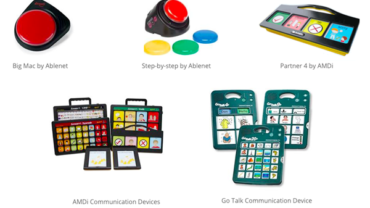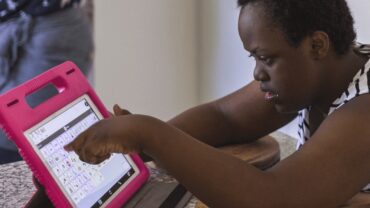What is AAC?
Augmentative and Alternative Communication (AAC) is a set of tools and strategies that an individual uses to solve everyday communicative challenges. Communication can take many forms, such as speech, a shared glance, text, gestures, facial expressions, touch, sign language, symbols, pictures, speech-generating devices, etc. Everyone uses multiple forms of communication based on the context and our communication partner. Effective communication occurs when the intent and meaning of one individual are understood by another person. The form is less important than the successful understanding of the message.
AAC can take many forms:
No-Tech + Low-Tech:
- Gestures/sign language and facial expressions
- Writing
- Drawing
- Spelling words by pointing to letters
- Pointing to photos, pictures, or written words
Mid-Tech:
- Recordable battery-operated devices
High-Tech
- iPad or tablet with an AAC app
- Specialized computer with built-in speakers, usually called a speech-generating device
Who Benefits from AAC?
Anyone who is not able to use speech to communicate effectively in all situations may benefit from using AAC.
They may demonstrate impairments in various areas:
- Motor speech impairment (difficulty using their mouth to make speech sounds)
- Language delay (difficulty with understanding others’ speech or using words meaningfully)
- Speaking but hard to understand (everyone or just unfamiliar listeners)
- Situational (emotional overwhelm or social anxiety)
AAC can be especially helpful for Autistic individuals due to their multiple sensory, motor, and social needs
Children with the following diagnoses may benefit from using AAC, either short-term or long-term:
- Cerebral Palsy
- Autism Spectrum Disorders
- Developmental language delays
- Apraxia of Speech
- Developmental language disorders
- Down syndrome and other syndromes/genetic disorders
- Traumatic brain injury
- Stroke/Aphasia
Common Myths about AAC
Deciding who is a good candidate for AAC and how to support them can feel difficult because of several pervasive myths about high-tech AAC. Here are some of the most common myths and truths regarding AAC:
Myth #1: AAC is only used by people who cannot communicate verbally.
Truth: AAC can be used by a wide variety of communicators. We all augment our verbal communication with gestures, facial expressions and so forth. AAC is useful for children with delayed speech development, and is even used by people who are learning a second language.
Myth #2: The primary goal of communication is to express wants and needs.
Truth: For most people, in most situations, expressing wants and needs is secondary to social expression. One way to think of this is to put yourself into the position of a person who uses AAC. If you could only say three things, would they be “I need to go to the toilet,” “I’m hungry,” and “I’m thirsty,” or would they be “Hi, how are you?” “Can we talk?” and “I love you”? This is not to say that being able to control your environment is not important, but it may not be the most important (or motivating) thing.
Myth #3: Using AAC will delay speech development.
Truth: Studies show that the use of AAC actually improves speech development where possible, and it can be argued that it improves language development in all cases.
Myth #4: We should wait to use AAC until a person is ready for it.
Truth: Anybody can use AAC. We do not wait to communicate verbally with a typical child until they are ready to talk; rather, we surround them with a wealth of language. The same can be said for a child who uses AAC. We should not wait to introduce other methods of communication until they are ready to use them. Rather, we should surround them with a wealth of language (verbal, gestural or symbolically based).
Myth #5: We should not overwhelm somebody with access to too many symbols.
Truth: We should provide more symbols than a child can use at one time. Again, if we look at typically developing children, they have access to all the sounds of their language by 6 months of age. They use them appropriately when they are able to. The same can be said for someone communicating with symbols. If a child is not provided with any more symbols than they have ‘mastery’ of, then they have no opportunity to practice new symbols in a natural progression.
Myth #6: Somebody who has a communication device should use it all the time.
Truth: Communication devices are often vital components of a person’s AAC system. It is true that they should have access to their device all the time (or almost all the time). But, there are times when it is not practical or necessary. For example, using a high-tech device in the bath is not usually a good idea. Communication is, in its nature, multi-modal; for example, many people use communication devices in most situations but not at home with their family.
Myth #7: An AAC system should be a goal for all people who are non-verbal.
Truth: The ‘goal’ is to communicate effectively, regardless of the modality. An AAC system may be a useful tool towards that end. This distinction, while subtle, can help tremendously toward setting appropriate goals for a student.







